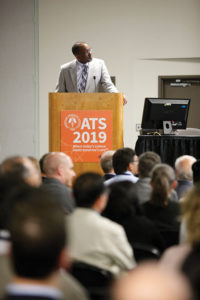
Gary Gibbons, MD, set the stage for four speakers to review the substantial progress and groundbreaking discoveries that have led to improved outcomes.
In the 50 years since the NIH’s Division of Lung Diseases (DLD) launched, it has facilitated groundbreaking science that is leading to improved outcomes for lung diseases.
“It is a virtuous cycle of success to turn discovery science into improving lung disease outcomes,” said Gary Gibbons, MD, director of the National Heart, Lung, and Blood Institute and co-chair of Monday’s session.
Speakers (as well as researchers via video; see ‘Future Giants’ Share Research) reviewed key scientific advances in pulmonary health and disease that illustrated DLD’s celebrated role. Speakers explored the history, research, clinical trials, treatments, and roads ahead for asthma, respiratory distress syndrome in neonates, COPD, and ARDS.
Jeffrey Drazen, MD, editor in chief of the New England Journal of Medicine, explored the evolving treatments of asthma beginning in 1969, starting with epinephrine, med inhalers, salbutamol/albuterol, cortisone, and interleukins. Dr. Drazen described how the prevalence of asthma has also encouraged lots of pharma-supported research.
“Now, we have four biologics. We are waiting for the results of NHLBI’s Expert Panel Report 4 Working Group,” he said. “I think in the next decade we will learn how to use the drugs in a way that makes sense. We don’t know about new biologics. We don’t know the relative effectiveness.
“We have made great progress,” he said. For the future, he recommends phenotyping asthma by genotype, using ancestry informative markers, and stopping use of self-declared race” as ways to prevent asthma.
Reviewing 50 years of respiratory distress syndrome in neonates, Jeffrey A. Whitsett, MD, a pediatrician at Children’s Hospital Medical Center in Cincinnati, said there was no intensive care for neonates with RDS in 1969.
“Back then, virtually every baby with it died; today, it is a rare moment. Science and reality took the application of physiology, engineering, and biochemistry and allowed it to go away.”
Through research, the community has learned of the “symphony of change that courses through the body thanks to the lungs,” he said. Ultimately, critical findings revealed the role surfactant plays in the development of lungs and has led to surfactant replacement therapy and the potential of lung remodeling. Today, he said, we are using those findings to begin to tackle some of the adult diseases of the lung.
COPD “has been climbing the leaderboard, but not in a good way,” said MeiLan K. Han, MD, MS, University of Michigan, Ann Arbor, of the third leading cause of death globally. From its early days, she said there was a “dismissiveness of COPD” because it was viewed as a disease of the old or the patient who brought it on themselves via cigarette smoking. However, data from around the world shows it to be a disease of the young. “We do not yet fully understand all of this data, but we look to poor air quality.” Declaring COPD an epidemic, she cited important milestones in the last 50 years, including development of the spirometer, improved definitions of COPD, distinctions for diagnostic standards, the benefits of smoking cessation, and the protease-antiprotease hypothesis.
Although there has been significant improvements in outcomes of acute respiratory distress syndrome, Carolyn S. Calfee, MD, University of California, San Francisco, said there is still room for improvement.
Understanding the broader implications of ARDS by encouraging experimental research will allow for post-critical illness recovery and will make a global impact, she said. “We must be patient because it can take years to translate learning into patient outcomes and treatment,” she said.
In closing, Dr. Gibbons commended the 50 years of work for bringing about hope, optimism, and confidence.
“We have done a lot, but there is a lot of work left to do,” he concluded. “We look forward to a day when we do not see chronic lung disease at all.”
‘Future Giants’ Share Research
Five emerging scientists, who Polly Parsons, MD, ATSF, called “future giants” during the President’s Symposium, shared information about their research via video.
Tien Peng, MD
Studying the biology of the fibroblasts that sit adjacent to epithelial stem cells in the lungs.

Polly Parsons introduced researcher videos from “future giants.”
Denise Al Alam, PhD
Seeking to understanding the mechanisms that go into the development of the human lung.
Susan Berket, PhD
Researching the interaction between the abnormal levels of mucous in the airways of patients with cystic fibrosis and bacteria in those airways.
Bradley Maron, MD
Investigating pulmonary arterial hypertension and other pulmonary vascular diseases.
Hassina Outtz Reed, MD, PhD
Using mouse modeling to understand pulmonary vasculature, in general, and pulmonary lymphatics, in particular.
